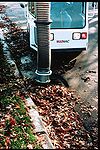
Difference between revisions of "Municipal prevention practices for TSS"
m |
m |
||
| Line 7: | Line 7: | ||
<th>Relative effectiveness</th> | <th>Relative effectiveness</th> | ||
<th>Method</th> | <th>Method</th> | ||
| − | <th>Image</th> | + | <th>Image<sup>1</sup>[[Pollution prevention#Photo credits</th> |
</tr> | </tr> | ||
<tr> | <tr> | ||
| Line 28: | Line 28: | ||
</tr> | </tr> | ||
<tr> | <tr> | ||
| − | <td>Material Storage Control | + | <td>Material Storage Control</td> |
<td>High</td> | <td>High</td> | ||
<td>Reduce or eliminate spill and leakage loss by properly inspecting, containing, and storing hazardous materials and having a cleanup plan that can be quickly and efficiently implemented.</td> | <td>Reduce or eliminate spill and leakage loss by properly inspecting, containing, and storing hazardous materials and having a cleanup plan that can be quickly and efficiently implemented.</td> | ||
| Line 34: | Line 34: | ||
</tr> | </tr> | ||
<tr> | <tr> | ||
| − | <td>Better Street and Parking Lot Cleaning | + | <td>Better Street and Parking Lot Cleaning</td> |
<td>High</td> | <td>High</td> | ||
<td>Maintain streets and parking lots frequently and especially in the spring by sweeping, picking up litter, and repairing deterioration; pressure wash pavement only as needed and avoid using cleaning agents.</td> | <td>Maintain streets and parking lots frequently and especially in the spring by sweeping, picking up litter, and repairing deterioration; pressure wash pavement only as needed and avoid using cleaning agents.</td> | ||
| Line 40: | Line 40: | ||
</tr> | </tr> | ||
<tr> | <tr> | ||
| − | <td>Proper Vehicle Management | + | <td>Proper Vehicle Management</td> |
<td>High</td> | <td>High</td> | ||
<td>Ensure that vehicles are fueled, maintained, washed and stored in a manner that prevents the release of harmful fluids, including oil, antifreeze, gasoline, battery acid, hydraulic and transmission fluids, and cleaning solutions.</td> | <td>Ensure that vehicles are fueled, maintained, washed and stored in a manner that prevents the release of harmful fluids, including oil, antifreeze, gasoline, battery acid, hydraulic and transmission fluids, and cleaning solutions.</td> | ||
| Line 58: | Line 58: | ||
</tr> | </tr> | ||
<tr> | <tr> | ||
| − | <td>Better Turf Management | + | <td>Better Turf Management</td> |
<td>Moderate</td> | <td>Moderate</td> | ||
<td>Ensure that mowing, fertilization, pesticide application, and irrigation are completed in ways that will prevent or reduce grass clippings, sediment, and chemicals from entering storm sewer systems; use native vegetation where possible.</td> | <td>Ensure that mowing, fertilization, pesticide application, and irrigation are completed in ways that will prevent or reduce grass clippings, sediment, and chemicals from entering storm sewer systems; use native vegetation where possible.</td> | ||
Revision as of 19:30, 25 February 2015
Municipal prevention practices for TSS.
Link to this table
| Practice | Relative effectiveness | Method | Image1[[Pollution prevention#Photo credits |
|---|---|---|---|
| Temporary Construction Sediment Control | High | Implement and encourage practices to retain sediment within construction project area; see Temporary Construction Erosion and Sediment Control Factsheets for additional information | |
| Wind Erosion Control | High | Institute a local program for wetting of open construction surfaces and other sources for windblown pollutants. | |
| Streambank Stabilization2 | High | Repair erosion occurring on a streambank of lakeshore in a timely manner; inspect bank areas for ice damage in the spring. | |
| Material Storage Control | High | Reduce or eliminate spill and leakage loss by properly inspecting, containing, and storing hazardous materials and having a cleanup plan that can be quickly and efficiently implemented. | |
| Better Street and Parking Lot Cleaning | High | Maintain streets and parking lots frequently and especially in the spring by sweeping, picking up litter, and repairing deterioration; pressure wash pavement only as needed and avoid using cleaning agents. | |
| Proper Vehicle Management | High | Ensure that vehicles are fueled, maintained, washed and stored in a manner that prevents the release of harmful fluids, including oil, antifreeze, gasoline, battery acid, hydraulic and transmission fluids, and cleaning solutions. | |
| Storm Sewer System Maintenance | High | Regularly clean debris from storm sewer inlets, remove sediment from catch basin sumps, and remove any illicit connections to storm sewer systems. | |
| Better Street and Parking Lot Deicing | Moderate | Properly store and conservatively apply salt, sand, or other deicing substances in order to prevent excessive and/or unnecessary contamination; implement anti-icing and prewet salt techniques for increased deicing efficiency. | |
| Better Turf Management | Moderate | Ensure that mowing, fertilization, pesticide application, and irrigation are completed in ways that will prevent or reduce grass clippings, sediment, and chemicals from entering storm sewer systems; use native vegetation where possible. | |
| Public Education | Moderate | Label storm drains to indicate that no dumping is allowed and institute pollution prevention programs to educate and implement needed community practices. | |
| Staff, Employee, and Volunteer Education | Moderate | Provide internal training for staff and provide direction to hired employees or volunteers regarding pollution prevention techniques to be used during work activites. |
2Reductions in pollutant loading associated with this BMP are not eligible for credit toward NPDES permit requirements unless the stabilization is above the ordinary high water mark (i.e. the work is not completed within a Water of the State), prior to a permittee's discharge, and the load reduced from this action is included in a Wasteload Allocation in a U.S. EPA-approved TMDL.









